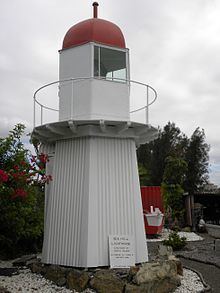Deactivated 2006 Height 13 m | Focal height 33 m | |
 | ||
Location Curtis IslandQueenslandAustralia Year first constructed 1873 or 1876 (first)1895 (second) Tower shape conical frustum tower with balcony and lantern Markings / pattern white tower, red lantern dome | ||
Sea Hill Lighthouse, also known as Sea Hill Point Light Little Sea Hill Light, was a lighthouse on the northwest point of Curtis Island, Queensland, Australia. Its purpose was to mark the east side of the entrance to Keppel Bay, on passage to Fitzroy River and Port Alma. The first lighthouse at the locations was constructed in 1873 or 1876, moved in the 1920s, and is now on display at the Gladstone Maritime Museum. A second lighthouse was constructed in 1895, deactivated in 2006 and demolished in early 2009.
Contents
First lighthouse
The first lighthouse, constructed in 1873 or 1876, was the first in Queensland of its design, made of a hardwood frame clad with corrugated iron. This design was then used in seven more lighthouses, by order of establishment, Grassy Hill Light, Goods Island Light, Bay Rock Light, Old Caloundra Light, North Point Hummock Light (demolished), Gatcombe Head Light (demolished) and Bulwer Island Light. With the installation of the second lighthouse in 1895 it became the front light in the range. In the 1920s, the lighthouse was relocated to Station Point, about 6 kilometres (3.7 mi) northeast. It stood there until it was deactivated in the 1960s and then sold into private hands. It is currently on display at the Gladstone Maritime Museum at 23°50′4″S 151°15′37″E.
The lighthouse is rather short, only 20 feet (6.1 m) in height. Unlike the other seven Queensland lighthouse towers of the corrugated iron clad type, it is hexagonal in plan, rather than round. A gallery and a lantern top the tower, and much like other Queensland lighthouses, it is painted white with a red dome.
Second lighthouse
The second lighthouse was constructed in 1895 and for a while served as the rear light in the range. It had a 7.87-metre-high (25.8 ft), timber framed corrugated galvanized iron clad tower, with a lantern and a balcony. The original optical apparatus was a 4th order fixed lens with kerosene wick burner. In 1930 the light was converted to acetylene lighting, with sun valve and flasher. By 1977 the original lens had been removed and a solar powered Tideland ML-300 electric beacon installed. A pilot station was established on the foreshore nearby in 1919, and closed in 1963.
2014 - the lighthouse is still there standing tall, but not kept lit.
It is visited by people interested in history and also Amateur Radio Enthusiasts during the annual International Lighthouse Lightship Weekend (ILLW) - http://illw.net/
For a few years now, members of the 'Central Queensland Amateur Radio Association inc' - http://www.cqara.org.au/ - have travelled by boat to visit the lighthouse, set up amateur radios and contacted other Amateur Radio Enthusiasts around the world also stationed at lighthouses for the International Lighthouse Lightship Weekend.
